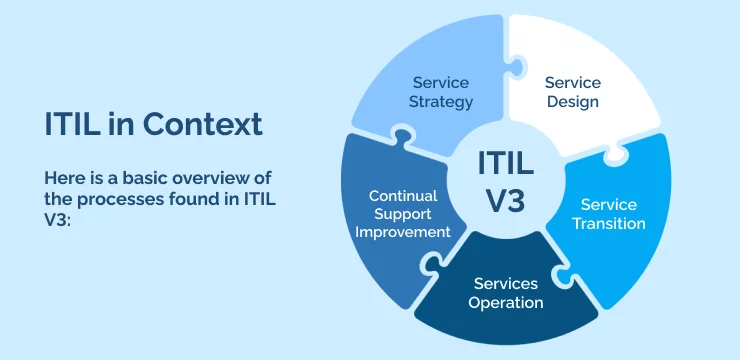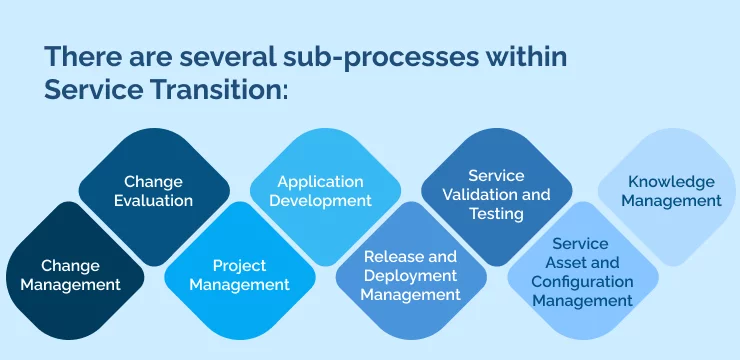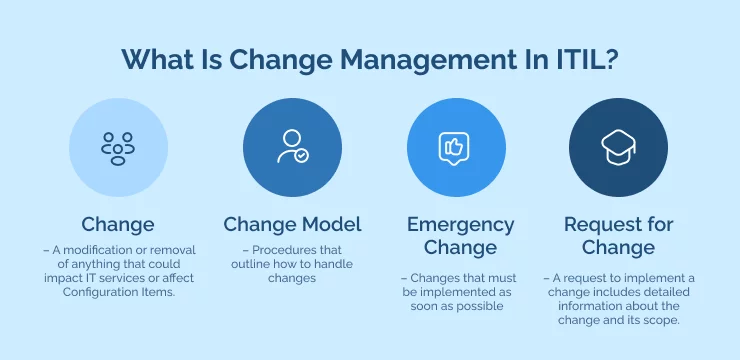
Change management vs. configuration management in ITIL – how are they different?
Below, we’ll explore these two processes in detail.
One commonly asked question about ITIL is the difference between change management and configuration management.
Let’s start with a brief overview of ITIL.
ITIL in Context

Let’s start from the broadest perspective: what ITIL is and how it works.
ITIL (Information Technology Infrastructure Library) is a framework for managing IT services. IT Services Management (ITSM) departments worldwide use this set of guidelines. There are several versions of ITIL, the latest one released in February 2019 (V4).
However, since many ITSM platforms still use V3, we will cover that version here.
Here is a basic overview of the processes found in ITIL V3:
- Service Strategy – Developing a strategy to serve customers by analyzing the marketplace, customer needs, and the organization.
- Service Design – Development of new IT services or improvements to existing ones.
- Service Transition – Implementation of IT services in an organized way while attempting to minimize risk.
- Services Operation – Delivering IT effectively and efficiently.
- Continual Support Improvement – Adjust and optimize processes to improve over time continually.
These processes act as a straightforward set of guidelines that any IT department can follow. Managers can use them as a foundation for customizing and building their processes and workflows. Configuration Management and Change Management fall under the Service Transition category.
Let’s dive deeper into the five processes below.
Service Strategy
Service Strategy is the core of the ITIL Service Lifecycle. This stage guides an IT organization to take a market-driven approach to manage IT services through various concepts and techniques. It also directs organizations to prioritize investments in IT services to serve customers best.
ITIL Service Strategy starts with assessing the customer and market needs to determine what services to offer and the organization’s development capabilities. Aligning the IT vision with the business vision helps organizations think and act strategically in the long term. So strategy addresses the questions:
- What’s the best use for IT services for the organization?
- How do you differentiate the IT group from competitors?
- How will IT create value for customers?
ITIL breaks down Service Strategy into five process areas:
- Strategy Management for IT services – to make IT Service Management an asset by integrating IT with the business. In this process, the IT service provider seeks to understand the market, its strengths and weaknesses, and any opportunities.
- Service Portfolio Management (SPM)– to align the service portfolio with the service management strategy to maximize the portfolio’s business value and manage costs and risks. SPM evaluates proposed services while cooperating with the change management process.
- Business Relationship Management – to inform service selection and implement the chosen strategy. So it collaborates with strategy management and service portfolio management. The process aims to understand the customers’ need for the service and form a relationship with them.
- Financial Management for IT services – to track IT spending and investments. The goal is to deliver the highest possible quality at the lowest cost. The activities in this process are accounting, budgeting, and charging (capturing value).
- Demand Management – anticipating, understanding, and influencing customer service demand. This process ensures that allocated resources (technical and human) match the demand.
Service Design
ITIL Service Design stage is about turning strategic objectives into service assets and a portfolio of services. It guides the designing and developing of service management systems and IT services. This stage includes necessary changes to deliver or increase value over the service lifecycle. The goal is to design effective IT services requiring minimum lifecycle improvements.
The ITIL Service Design stage has the following process areas:
- Design Coordination – to coordinate all resources, service design activities, and processes.
- Supplier Management – to align supplier contracts with business requirements and ensure that the suppliers fulfill their contracts.
- Service Level Management – to negotiate Service Level Agreements (SLAs) with customers and design the services accordingly.
- Availability Management – to design, plan and measure the availability of IT services. The process also ensures the IT infrastructure, roles, and functions meet the SLAs.
- Capacity Management – to ensure that the IT infrastructure and services deliver the agreed service level targets on time and within budget.
- Service Catalogue Management – to produce and maintain a Service Catalogue with error-free information about all services.
- Information Security Management – to ensure all IT service data and the organization’s data are available, confidential, and accurate.
- IT Service Continuity Management – to manage risks and ensure that IT services meet the agreed service levels.
Service Transition
Service Transition is about deploying and configuring the new software to support recent activities. It includes the resources and steps needed to support users learning how to use the new system. The goal is to deploy services successfully, set correct expectations, provide the right information and knowledge, and realize the expected business value.
ITIL Service Transition includes the following processes:
- Change Management – to roll out changes to the project scope, baseline, etc., with minimal disruption. It consists of the process of setting up the change control board and emergency change advisory board, submitting a change request, authorization process, and documentation.
- Change Evaluation – to analyze significant changes.
- Project Management – to create a project management plan and coordinate the resources needed to deploy the change within the allocated time and budget.
- Service Asset and Configuration Management – to maintain the information about Configuration Items and their relationships.
- Release and Deployment Management – to control service releases and protect the integrity of the live services.
- Knowledge Management – to gather and share knowledge with the organization.
- Service Validation and Testing – to ensure that IT operations can support the changes and service releases meet the customer expectations.
- Application Development – to develop and maintain applications that provide the needed functionalities.
Services Operation
After deploying the changes, the Service Operation stage deals with the daily operation of the new services, the infrastructure, and processes needed to achieve the expected business value. The goal is to maintain authorized access to services, minimize service outages and their impact and deliver the agreed services efficiently.
ITIL Service Operation includes these process areas:
- Event Management – to monitor services, filter, and categorize events to determine the appropriate actions.
- Incident Management – to restore IT services quickly after unexpected disruptions.
- Request Fulfillment – to acknowledge and process client requests (e.g., password changes).
- Problem Management – to find the root cause of problems, prevent them or minimize their impact.
- Access Management – to control access to services (e.g., block unauthorized users)
Continual Support Improvement (CSI)
Continual Support Improvement is about evolving with changing needs (business and technical needs). ITIL CSI provides best practices for service improvements, business continuity planning, and operational efficiency. The focus is on improving services to support business processes.
CSI defines a 7-step process to identify, define, analyze, and implement improvements:
- Identify the improvement approach
- Define what to measure and create a measurement plan
- Gather data by monitoring the service persistently
- Process the data (e.g., create Key Performance Indicators)
- Analyze the data to find gaps and understand their impact
- Present the data to support decision-making
- Implement the improvements
ITIL CSI has four main process areas:
- Service Review – to review the services regularly to identify improvement opportunities.
- Process Evaluation – Audit, benchmark, and review processes to identify unfulfilled process metrics.
- Definition of CSI Initiatives – to define improvement initiatives after service review and process evaluation.
- Monitoring of CSI Initiatives – to verify that the initiatives roll out according to the plan and correctly.
Service Transition in ITIL: A Quick Overview

Service Transition, as mentioned, is a set of steps and processes designed to help organizations build and deploy services.
There are several sub-processes within Service Transition:
- Change Management
- Change Evaluation
- Project Management
- Application Development
- Release and Deployment Management
- Service Validation and Testing
- Service Asset and Configuration Management
- Knowledge Management
These processes work together to create a framework for effectively managing and deploying IT service changes.
Let’s focus on change management vs. configuration management.
What Is Configuration Management?

Configuration management is short for Service Asset and Configuration Management. It is a constant process for maintaining records about an organization’s software and hardware composition, including updates. Configuration management focuses on controlling the assets needed to deliver IT services.
A few key concepts in the configuration management process include:
- The Configuration Model – A logical model of IT’s service assets
- Configuration Management System – Tools and data for managing information about Configuration Items and their relationships
- Configuration Items – A unit with the model, such as a policy, documentation, employees, etc., which is characterized by its relationship to other Configuration Items
Configuration Management has four sub-processes of its own:
- Configuration Identification – Defining and maintaining the Configuration Model’s structure so that it can hold information on the Configuration Items (CIs)
- Configuration Control – Ensuring that Configuration Items are authorized
- Configuration Status Accounting – Reporting and recording configuration baselines associated with the CIs
- Configuration Verification – Performing regular checks to ensure the Configuration Model and Configuration Items are in sync
These processes are managed and owned by the Configuration Manager. They help record, manage, and maintain configuration information about services.
Let’s explore these processes below.
The Configuration Model
ITIL Configuration Model records relationships between Configuration Items (CIs) and their attributes to deliver a model for the assets, services, and infrastructure. It’s typically a data model or set of documents. Organizations only include relationships that create more business value than maintenance costs. The model facilitates assessing change impact and service outage impact, planning technology improvements, and optimizing resources.
Configuration Items (CIs)
Configuration Items are the assets that need management to deliver IT services. These include software, hardware, IT services, people, buildings, and documentation like SLAs. They are entities in Configuration Management Systems.
Organizations record information about each CI in Configuration Records within Configuration Management Systems. A configuration management plan must define a way to reconcile this data and provide a single source of truth to avoid overlapping data from different sources in the organization. Overall, CIs are under Change Management’s control.
The types of Configuration Items in ITIL include:
- Service Lifecycle CIs – provides information about the services (type, expected benefits, costs, how and when to deliver the service)
- Service CIs – service model, service package, release package, service resource assets (capital, tools, and facilities), and service capability assets (processes, organization, and knowledge)
- Organization CI – internal documents (e.g., policy and business strategy)
- Interface CI – for delivering end-to-end services.
- Internal CI – individual project deliverables
- External CI – customer agreements and requirements, supplier releases, and other external services
Configuration Management System (CMS)
ITILv3 introduced the Configuration Management System concept to replace Configuration Management Database (CMDB). It is the set of tools for collecting, analyzing, storing, updating, and presenting information about the Configuration Items and their corresponding relationships.
The Configuration Model defines the structure of a CMS, which specifies CI types, their relationships, and their attributes. A CMS typically manages more than one CMDB.
Configuration Identification
ITIL Configuration Identification defines and maintains the CMS structure. It specifies Configuration Item attributes, their sub-components, and relationships. So Configuration Identification is identifying which characteristics define a Configuration Item. An established configuration management process and open communication facilitate the process.
Organizations baseline and record the attributes in configuration management documents. If a baselined attribute changes, it demands a formal change management process.
Configuration Control
Configuration change control sets out the approval stages and process for changing CI attributes or baselines. It ensures that all changes are authorized and recorded. However, ITIL Configuration Control reviews changes in the CMS to ensure the data’s integrity.
Configuration Status Accounting
Configuration Status Accounting is about recording and reporting Configuration Management data. It answers these questions:
- What’s the proposed change?
- What’s the approved change?
- What modifications have we made?
- What CIs changed and when?
Configuration Verification and Audit
Functional configuration audits/verifications ensure that Configuration Items achieve their functional and performance attributes, while physical verifications ensure that CIs conform to the requirements defined in the project documentation. In addition, the audits ensure that a CI’s information in the CMS matches the CI in the live environment.
What Is Change Management In ITIL?

Change Management in ITIL, as mentioned, aims to control the life cycle of changes and minimize disruptions to IT services.
Here are a few key concepts found within this process:
- Change – A modification or removal of anything that could impact IT services or affect Configuration Items.
- Change Model – Procedures that outline how to handle changes
- Emergency Change – Changes that must be implemented as soon as possible
- Request for Change – A request to implement a change includes detailed information about the change and its scope.
There are many more processes within ITIL Change Management:
- Change Management Support
- Assessment of Change Proposals
- RFC Logging and Review
- Assessment and Implementation of Emergency Changes
- Change Assessment by the Change Manager
- Change Assessment by the CAB
- Change Scheduling and Build Authorization
- Change Deployment Authorization
- Minor Change Deployment
- Post Implementation Review and Change Closure
This change management system helps organizations effectively assess, plan, implement, log, and review changes to IT services.
Difference between Change Management and Configuration Management
Change Management focuses on identifying, authorizing, rejecting, and tracking changes to a project baseline, documents, or deliverables.
In contrast, Configuration Management deals with identifying, recording, and verifying Configuration Items, their relationships, and their attributes. However, Configuration Management activities like configuration identification support change management.
ITIL V3 vs. ITIL V4
ITIL V4 represents a departure from V3, covered here.
Here are a few key characteristics of the new version:
- A four-dimensional model. These dimensions include organizations and people, information and technology, partners and suppliers, and value streams and processes.
- The service value system. Elements include guiding principles, governance optimization, service value chain, and others.
- Management practices. There are three main categories: general management practices, service management practices, and technical management practices. Each category has a subset of processes, such as incident management, release management, and service configuration management.
The critical difference is that ITIL V4 is less prescriptive. Rather than introducing a new set of processes, it takes a different perspective on the existing processes.
According to Axelos, “ITIL 4 expands on previous versions by providing a practical and flexible basis to support organizations on their journey to the new world of digital transformation.”
Therefore, organizations already using ITIL V3 don’t need to uproot their existing procedures.
What Else Can ITIL Change Management Achieve?
The processes covered here offer insight into the difference between ITIL Change Management and Configuration Management. For example, Change Management tracks, rejects, and approves changes to baselines, processes, and plans, while Configuration Management identifies and records the assets needed to deliver IT services.
However, ITIL is a complex set of guidelines that requires a bit of study.
It is also worth noting that ITIL may take on responsibilities that other departments handle – such as employee training or software implementation.
Therefore, IT managers should work closely with the C-suite to design ITIL processes that avoid redundancy and waste.
WalkMe Team
WalkMe spearheaded the Digital Adoption Platform (DAP) for associations to use the maximum capacity of their advanced resources. Utilizing man-made consciousness, AI, and context-oriented direction, WalkMe adds a powerful UI layer to raise the computerized proficiency, everything being equal.



